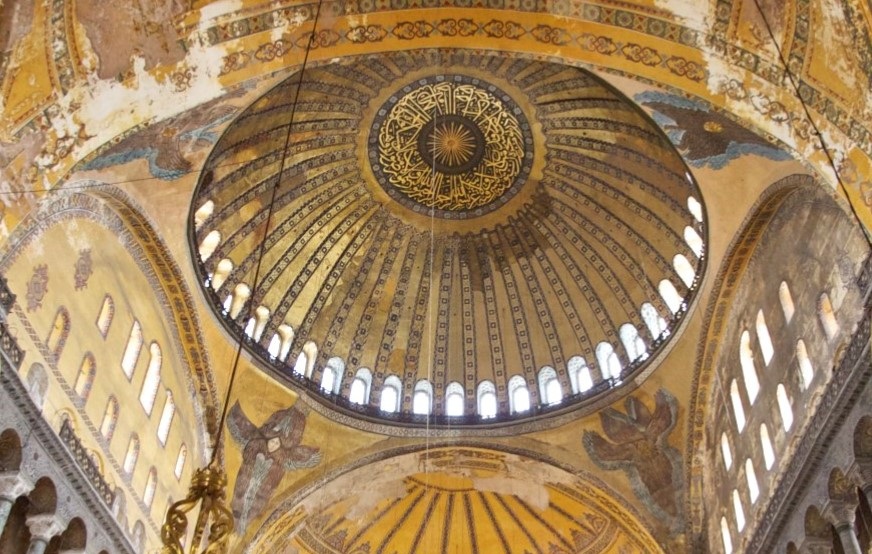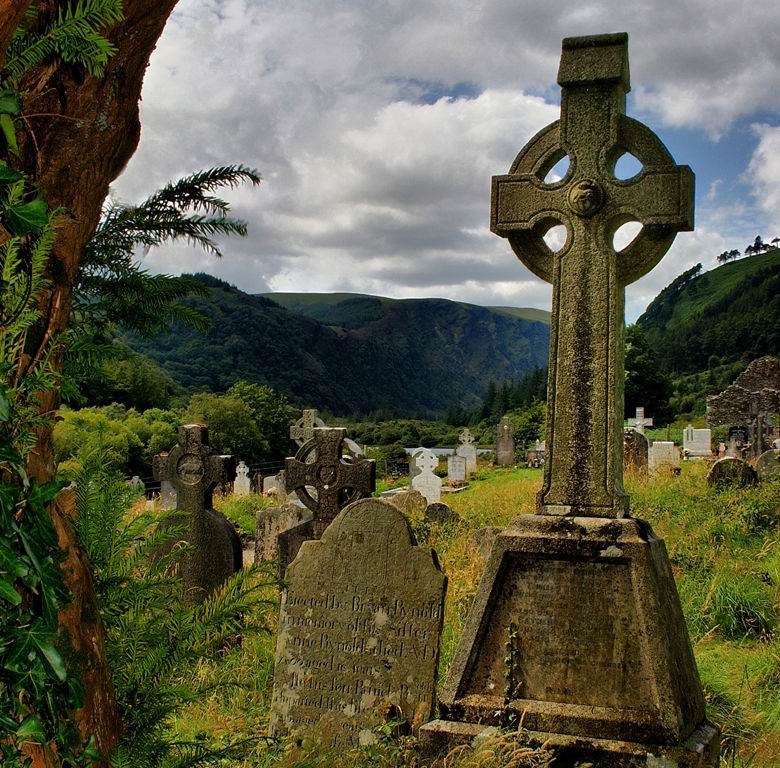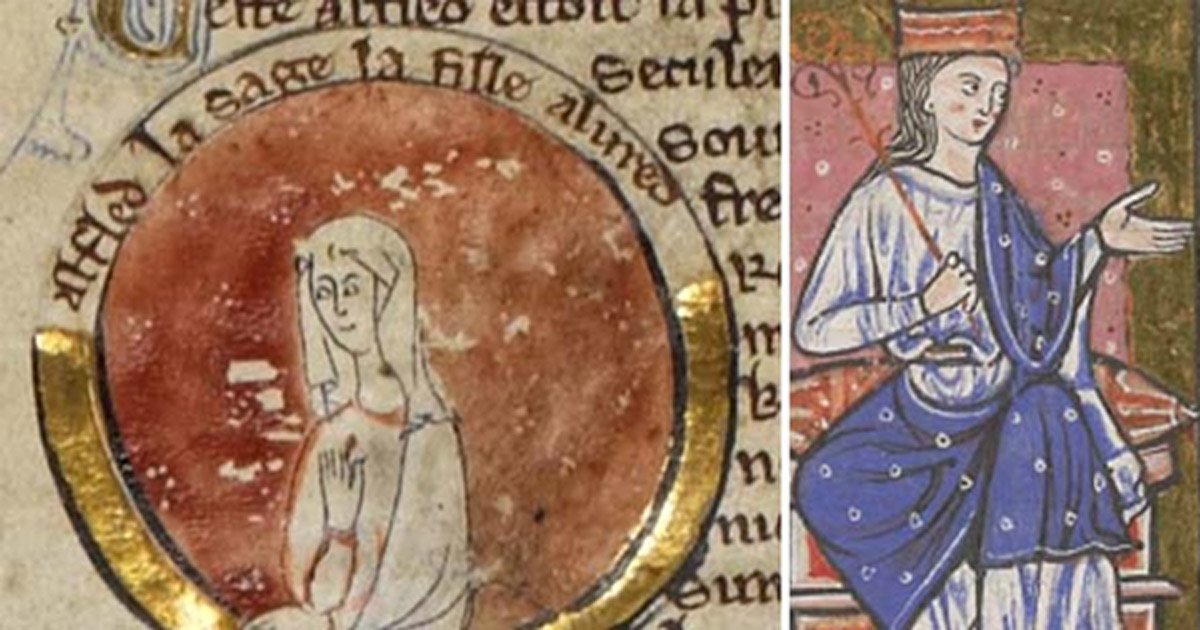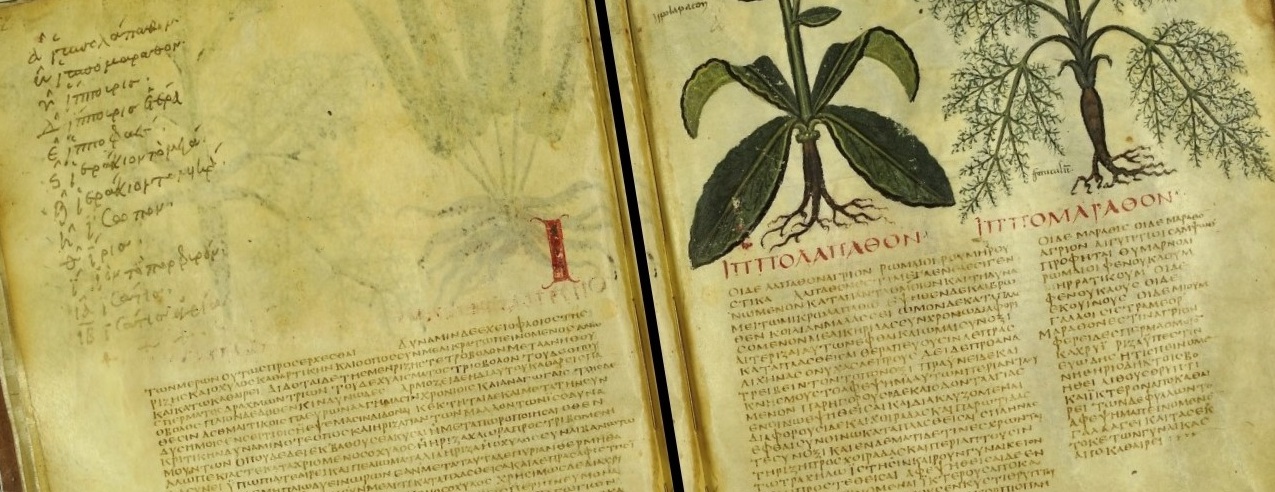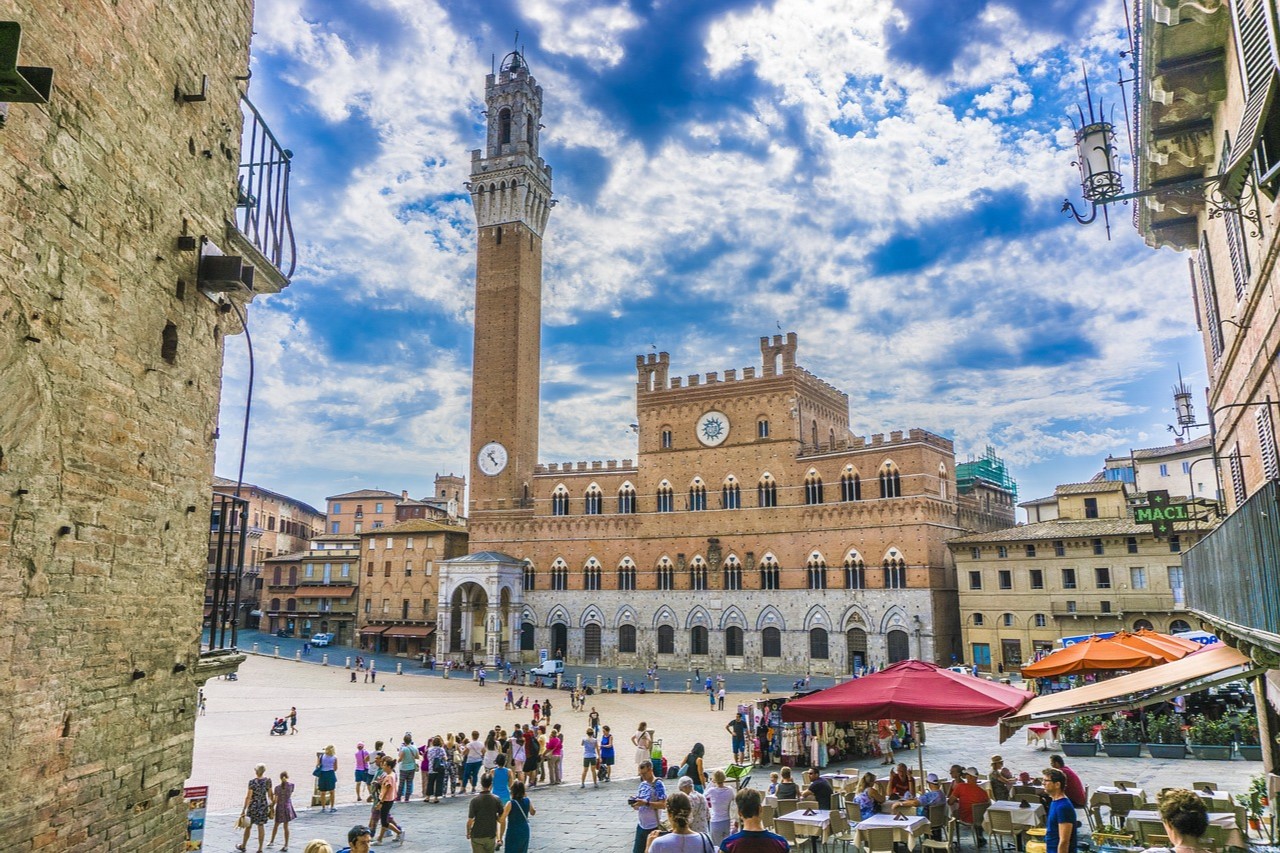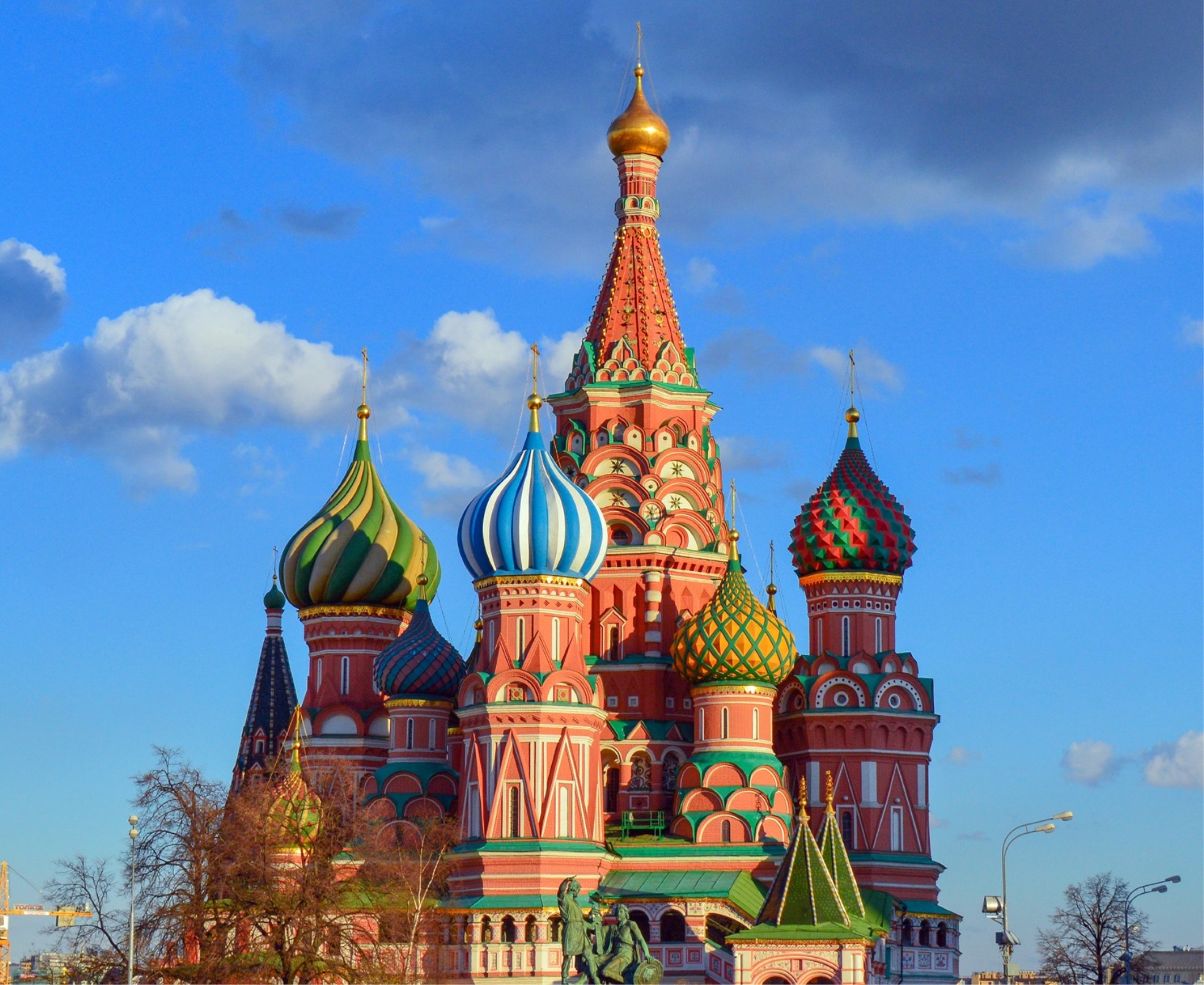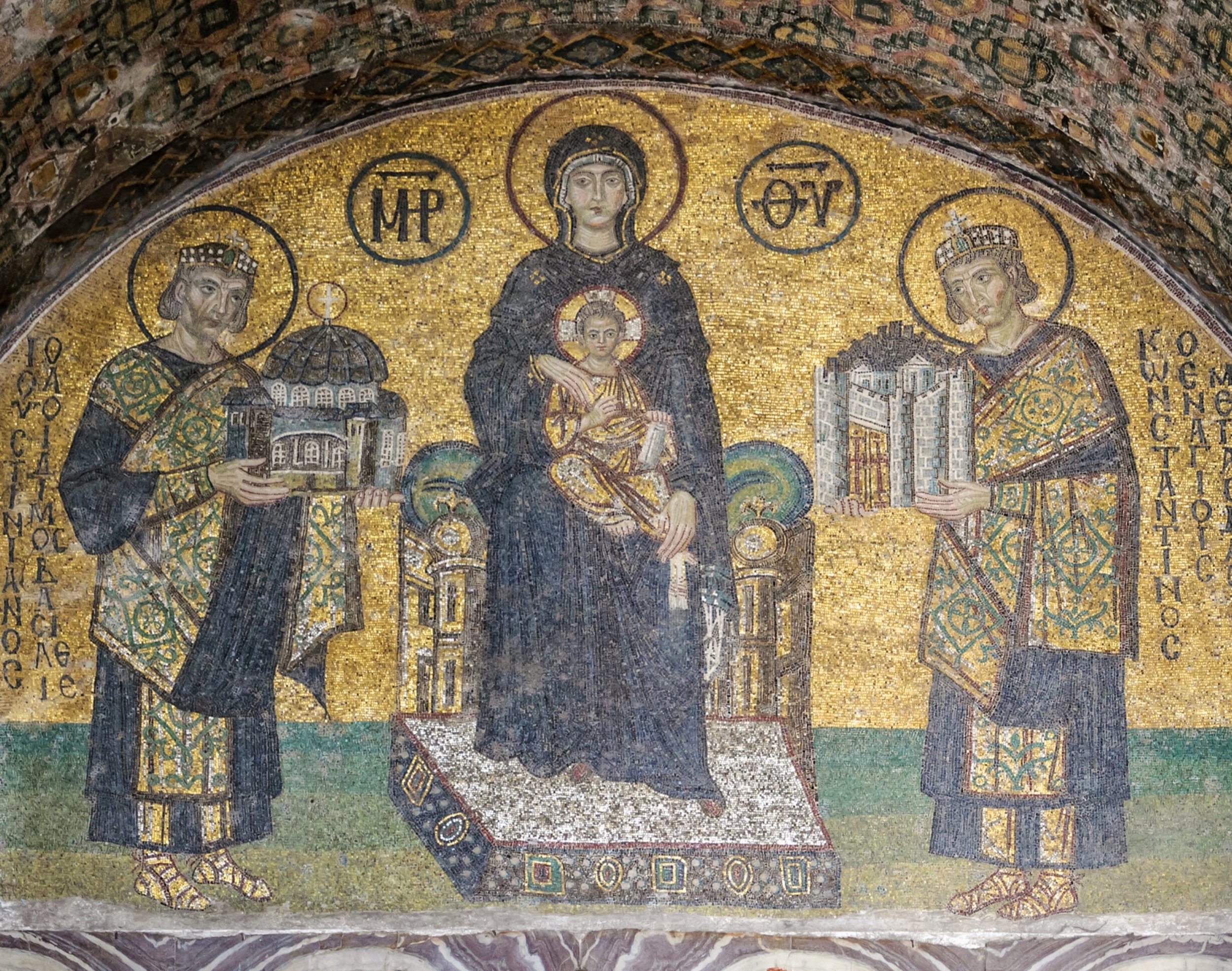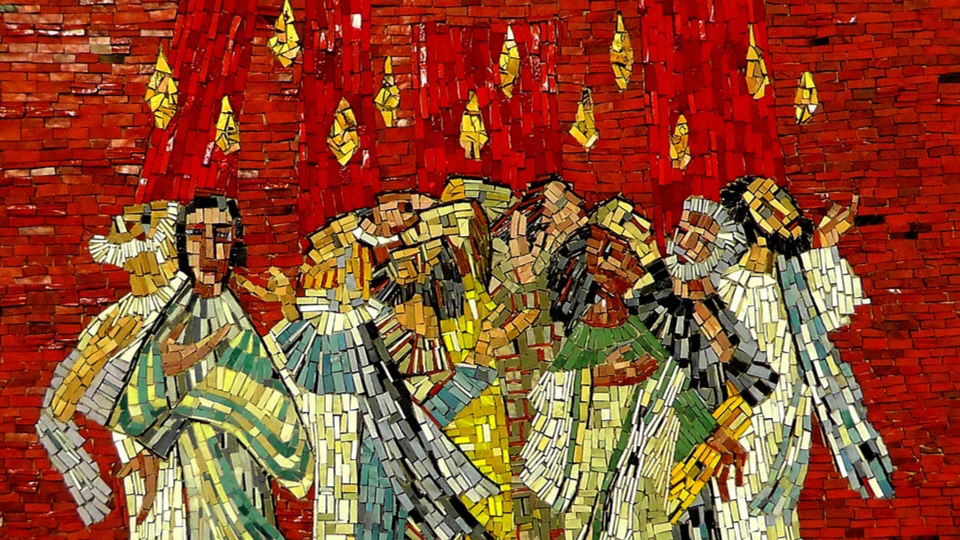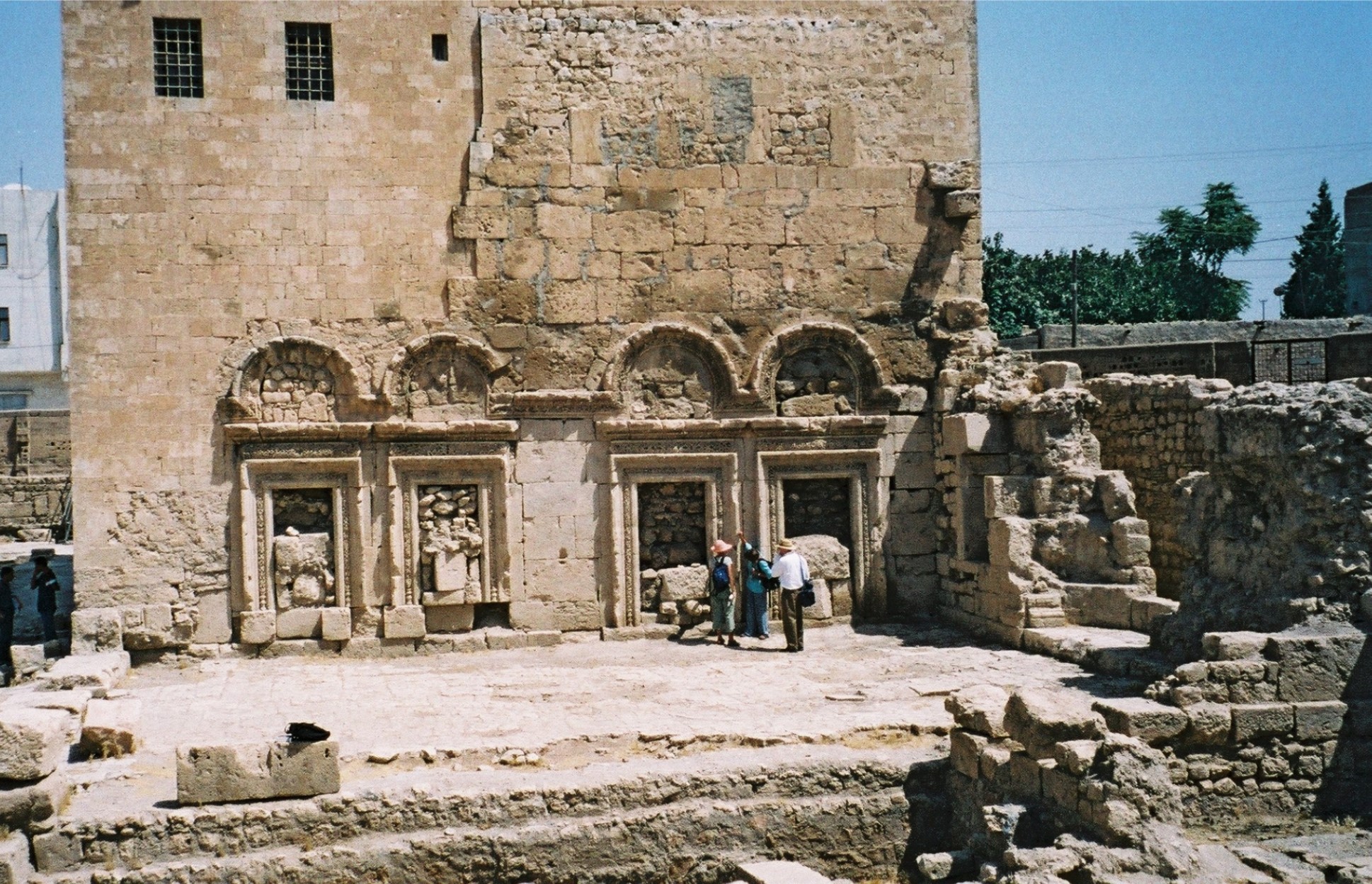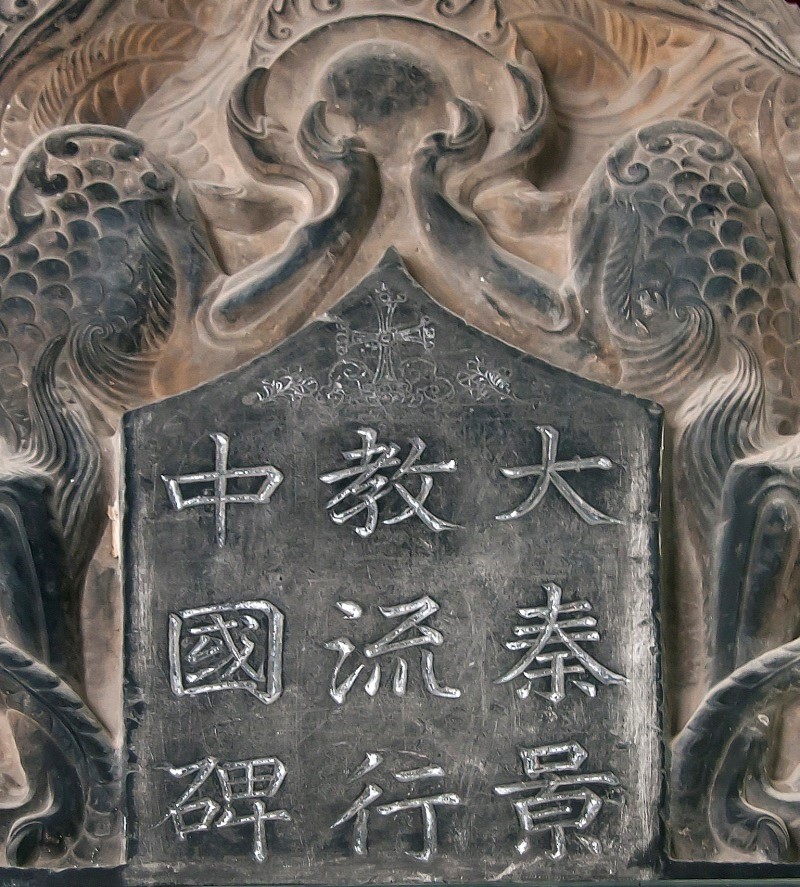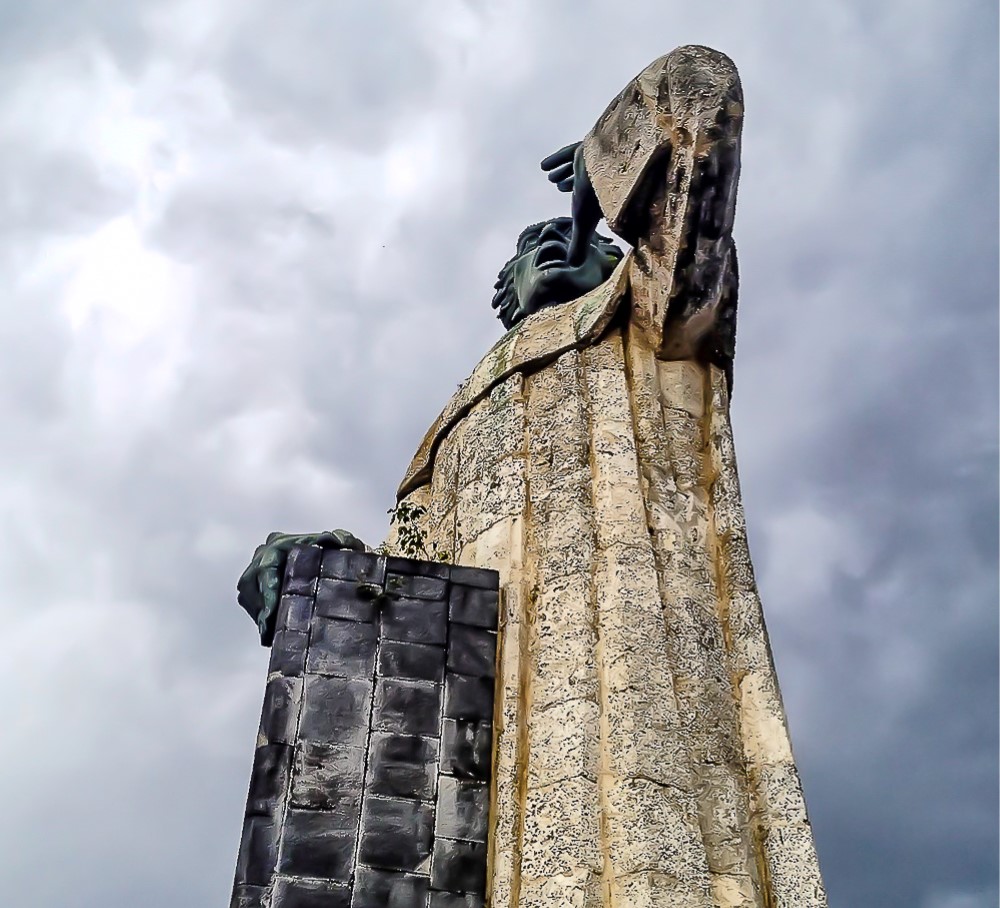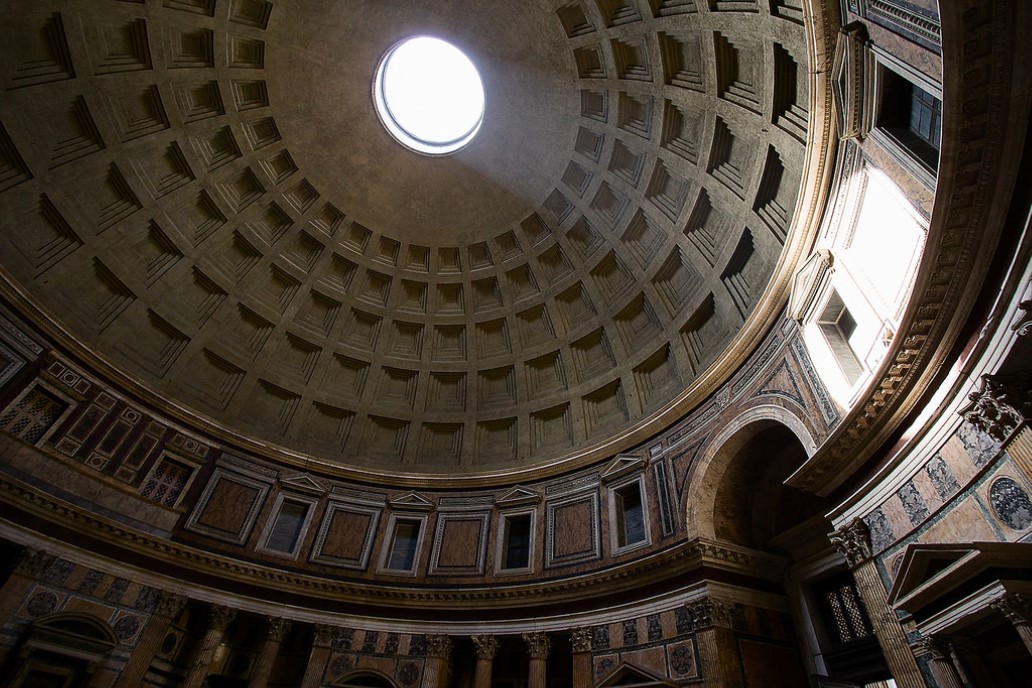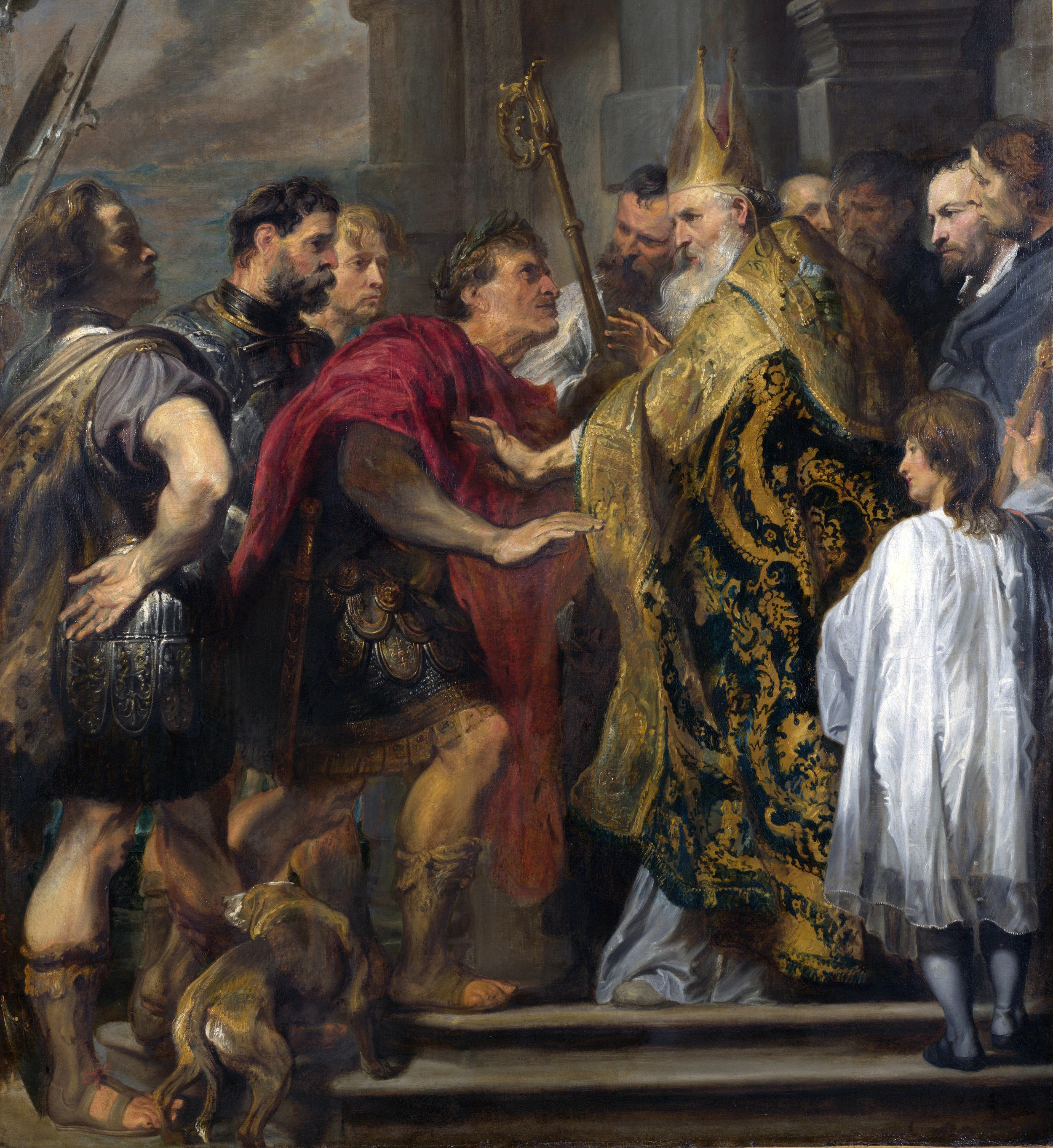The Church in the Roman Empire
313 - 800 AD
Photograph: This is the dome of Hagia Sophia, the great cathedral built in 532 - 537 AD by Roman Emperor Justinian in Constantinople, now a museum in Istanbul, Turkey. Photo credit: Dean Strelau | CC2.0, Flickr. The architecture of Hagia Sophia itself was meant to lead to worship. Prior to the conquest of the Turks in 1453 AD and its conversion to a Muslim mosque, the dome had a mosaic of Christ Pantocrator; Christian iconographic art reflected a synthesis of Semitic and Greek artistic styles. The architecture was Roman, as the Romans were the first architects who used domes to create large interior spaces. The dome in Christian use was designed to give the impression that Jesus, supported by light alone (streaming in from the windows), was descending from heaven to earth.
Introduction
The selection of perspectives on church history in this section — Church and Empire — has been guided by three factors: (1) to demonstrate that Christianity has not been a “white man’s religion”; (2) the study of empire as a recurring motif in Scripture by recent biblical studies scholars; and (3) explorations of biblical Christian ethics on issues of power and polity, to understand how Christians were faithful to Christ or not. Christian relational ethics continues a Christian theological anthropology that began with reflection on the human nature of Jesus, and the human experience of biblical Israel.
This section explores the experience and activities of Christians under the Roman Empire from Constantine’s Edict of Milan in 313, to the year 800, when Charlemagne, King of the Franks, claimed the title, “Emperor of the Romans,” while Emperor Irene ruled from Constantinople as Emperor of the Romans.
Other Resources on How the Church Shaped Empires in Europe 313 - 800 AD
Wikipedia, Byzantine Law - Ecloga. The Christian Impact on Roman Law in 3 phases: Phase 1 can be seen in Emperor Constantine’s changes in law and policy, especially with regards to slavery and using imperial funds to help families in poverty, as codified by Emperor Theodosius in the Codex Theodosius. Phase 2 can be seen in Emperor Justinian’s changes, codified by him in the Codex Juris Civilis. Phase 3 can be seen in Emperor Leo III’s changes, codified in the Byzantine Ecloga of 726 CE.
Basil the Great, John Chrysostom, Augustine, What Did the Early Church Say About Economic Justice? Plough. Sep 14, 2017.
Wikipedia, San Marino, a small democratic republic in Italy, a continuation of a Christian monastic community founded in 301 AD.
W.H.C. Frend, The Monks and the Survival of the East Roman Empire in the Fifth Century. Past & Present | Oxford University, Feb 1972. highlights both the positive and negative influence of popular monastic movements.
T.F. Torrance, The Grammar and Ground of Theology, lecture 5. Fuller Seminary, 1981. An audio lecture; at 46min mark compares Greek and Hebraic-Christian ways of thinking about images and realities.
R.W. Southern, Western Society and the Church in the Middle Ages. Penguin Books | Amazon page, Aug 16, 1990. Southern has very important facts about the Roman Popes of late Antiquity being Syrian, Greek, etc. When the Popes became uniformly Latin, the Roman Church became notably less interested in unity with the broader church.
Henry Chadwick, The Early Church. Penguin Books | Amazon page, 1993.
Jaroslav Pelikan, Christianity and Classical Culture: The Metamorphosis of Natural Theology in the Christian Encounter with Hellenism. Yale University Press | Amazon page, 1993. Adolf Harnack's view of a Hellenized Christianity, a disguised Paganism, is laid to rest in Pelikan's magisterial work. The use of Greek concepts and terminology was an unavoidable and necessary means of communication in making the Christian Gospel relevant to the world in which it appeared. The Trinitarian terminology of the Cappadocian Fathers, and its later application to Christology in the Chalcedonian and post-Chalcedonian periods, clearly show that such concepts as ousia, hypostasis, or physis are infused with Christian meaning, not Platonic or Aristotelian philosophical concepts or ideas. Three hypostases united in one essence . ousia., or two natures . physis. united in one hypostasis, are no part of either the Platonic or Aristotelian systems of thought. As Pelikan notes, the “Cappadocians represented the Christian message as an acceptance of what was correct in both Judaism and Classicism, coupled with an avoidance of the errors in each.” Fr. Florovsky described it as the "enchurching of Hellenism".
Timothy S. Miller, The Birth of the Hospital in the Byzantine Empire. Johns Hopkins University Press | Amazon page, 1997. Miller narrates from before Basil of Caesarea who started the hospital as an institution and urban monasticism to support it, throughout the hospital network and its medical achievements in the Byzantine period. See also Andrew T. Crislip, From Monastery to Hospital: Christian Monasticism and the Transformation of Health Care in Late Antiquity. University of Michigan Press | Amazon page, Apr 2005.
Rodney Stark, The Rise of Christianity: How the Obscure, Marginal Jesus Movement Became the Dominant Religious Force in the Western World in a Few Centuries. Harper San Francisco | Amazon page, May 9, 1997. Stark explores some of the behaviors demonstrated by the early Christians which led to its impact on the Roman Empire.
Christianity Today, The Conversion of Scandinavia: Christian History Timeline. Christianity Today, 1999.
Oliver O’Donovan, The Desire of Nations: Rediscovering the Roots of Political Theology. Cambridge University Press | Amazon page, 1999. O'Donovan deals with the biblical presentation of the church, states, and Israel - not simply 'church and state' - and does an excellent job in biblical exposition and church history. Sadly, the church did not always stay faithful to its intellectual and ethical inheritance. But it did have quite an impact on law and policy.
Oliver O’Donovan and Joan Lockwood O’Donovan, From Irenaeus to Grotius: A Sourcebook in Christian Political Thought. Eerdmans | Amazon page, 1999. Bibliographic summary by Patristic Evangelism, Readings in Patristic Ethics. Patristic Evangelism blog, date unknown.
Robert M. Frakes, Contra Potentium Iniuras: The Defensor Civitatis and Late Roman Justice. Google book, 2001.
Henry Chadwick, The Church in Ancient Society: From Galilee to Gregory the Great. Oxford University Press | Amazon page, 2001.
Henry Chadwick, East and West: The Making of a Rift in the Church: From Apostolic Times until the Council of Florence. Oxford University Press | Amazon page, 2003.
Peter Brown, Poverty and Leadership in the Later Roman Empire. Brandeis University Press | Amazon page, 2001. See Walter Brueggemann's review, How the Early Church Practiced Charity. Religion Online, Jun 14, 2003.
O.M. Bakke, When Children Became People: The Birth of Childhood in Early Christianity. Fortress Press | Amazon page, 2005. Bakke produces an absolutely invaluable study of how Christian faith made an enormous and decisive impact on how children were treated as fully human, overturning Greek and Latin practices of infanticide, etc. which accorded only instrumental value to infants and children
Bogdan Popescu, Human Rights in Early Christian Writings. Mozaic, 2005/1, also a pdf file.
Sophie Lunn-Rockliffe, Ambrosiaster's Political Theology. Oxford University Press | Amazon page, 2007. Lunn-Rockliffe’s Oxford dissertation.
Robert Miller, Syriac and Antiochian Exegesis and Biblical Theology for the 3rd Millenium. Gorgias Press | Amazon page, Dec 1, 2008.
David Bentley Hart, Atheist Delusions: The Christian Revolution and Its Fashionable Enemies. Yale University Press | Amazon page, 2010.
Kimberly Flint-Hamilton, Gregory of Nyssa and the Culture of Oppression. Center for Christian Ethics at Baylor University, 2010.
Roger Haydon Mitchell, Church, Gospel, and Empire: How the Politics of Sovereignty Impregnated the West. Wipf and Stock | Amazon page, Nov 15, 2011. Mitchell is helpful in his examination of European church history and Christian capitulation to state power and violence (Eusebius), military force against outsiders in the Crusades (Pope Innocent III), capital (Bank of England), and energy/biopower.
John Meyendorff, Imperial Unity and Christian Divisions: The Church 450-680 A.D.. St. Vladimir’s Press | Amazon page, Dec 13, 2011.
Kevin Knight, Influence of the Church on Civil Law. New Advent website, 2012.
Megan Kraus, The Concept of Childhood in Anglo-Saxon Culture: A Case Study. Academia.edu paper, Mar 12, 2012. Kraus discusses how Christian faith led to the honored burial of children who died prematurely, and what that signifies.
Peter Brown, The Rise of Western Christendom: Triumph and Diversity, A.D. 200-1000. Wiley-Blackwell | Amazon page, Feb 4, 2013. Brown surveys both East and West, though he focuses more attention on the West.
Ethan Gannaway, Saint Ambrose and Toleration. The Academy for the Study of Ambrose of Milan, Apr 4, 2013. Gannaway makes helpful historical remarks concerning Ambrose, given the bishop's engagement with political events.
Thomas Heyne, Reconstructing the World's First Hospital: The Basiliad. Hektoen International: A Journal of Medical Humanities, Spring 2015. See also The Cosmological Vision of St. Basil and the First Hospital. Servant of Prayer blog, Apr 8, 2014. and Father Johannes Jacobse, St. Basil the Great and Christian Philanthropy. American Orthodox Institute USA, Dec 20, 2014.
Brian Patrick Mitchell, Byzantine Empire - or Republic? The American Conservative, Aug 7, 2015. Mitchell makes the fascinating case that the Byzantine Emperors were less autocratic and more accountable to the people, the Senate, and the church.
Peter Wehner, The Christmas Revolution. New York Times, Dec 25, 2015.
Ronald Osborn, The Scandalous Origins of Human Rights. Veritas Forum, Jan 15, 2016.
Alan Kreider, The Patient Ferment of the Early Church: The Improbable Rise of Christianity in the Roman Empire. Baker Academic | Amazon page, Mar 29, 2016. Kreider provides an excellent treatment of literature on patience.
Jack Davila-Ashcraft, The Early Church on Government. Paleo-Orthodoxy, Oct 3, 2016.
J.T. Fitzgerald, Orphans in Mediterranean Antiquity and Early Christianity. Acta Theologica, 2016.
David Bentley Hart, Human Dignity Was a Rarity Before Christianity. Church Life Journal, Oct 26, 2017.
Benjamin Wiker, From a Moral-Historical Perspective, This Crisis is Worse Than You Realize. National Catholic Register, Aug 30, 2018. re: pedophilia. Within this lament for the Catholic sex abuse crisis lies the reason this is so bitter: Christian faith alone was the reason why pedophilia - once common in Greco-Roman life and culture - was dramatically curtailed and became a moral horror.
Trevor Saxby, ‘Always Enough’: Early Church Leader Basil of Caesarea and Sustainability. Making History Now blog, Sep 10, 2018.
Walter Scheidel, Escape from Rome: The Failure of Empire and the Road to Prosperity. Princeton University Press | Amazon page, Oct 2019. Scheidel explores the role of Christian faith from the fall of Rome in 476 as one of many factors.
David Noonan, Western Individualism Arose from Incest Taboo. Scientific American, Nov 7, 2019. “Researchers link a Catholic Church ban on cousins marrying in the Middle Ages to the emergence of a way of life that made the West an outlier.” Helpful social science perspective, even though credit for the “incest taboo” is misplaced. Credit must be given to early Christianity and Judaism.
Douglas A. Burton, Empress Theodora: Origins of Women’s Rights. Douglas A. Burton blog, Feb 5, 2020. Burton writes a very readable blog post, well footnoted, showing how brilliant Theodora was in handling women’s issues in Roman law on matters of rape, property and wealth, prostitution, marriage, divorce, and criminal justice for women. With Emperor Justinian, her contribution to the Corpus Juris Civilis stands at the heart of Western legal tradition.
Julie Posner, He Wants to Save Classics From Whiteness. Can the Field Survive? New York Times, Feb 2, 2021. “Dan-el Padilla Peralta thinks classicists should knock ancient Greece and Rome off their pedestal — even if that means destroying their discipline.” Posner includes historical insights about how ancient Greece and Rome were claimed by Western Europeans as their intellectual and cultural inheritance, all the way through the far-right white supremacists of today’s U.S. This article gestures towards how important it is to see the classical inheritance as challenged by the Judeo-Christian inheritance. Even though Posner does not explore the Christian challenge and contribution to Greece and Rome, the comparison begs to be made on: slavery, women, children, worship, violence, debt, civic punishment, etc.
Other Resources on How Empires Shaped the Church in Europe 313 - 800 AD
Church and Women in Leadership A compilation of essays, presentations, and resources arguing that women shared all levels of church leadership with men in the earliest stage of the church. The church shifted to having all male leadership likely because of the Roman legal and social tradition of disempowering women in law and the public sphere.
Authoritarianism: Augustine’s Authoritarian-Theocratic Synthesis A compilation of resources focused on the consequences of Augustine of Hippo’s decision to use state force to persecute the heretics. This opened a terrible door. Compare to how Christianity initially was for Religious Pluralism and Tolerance on the political level.
W.H.C. Frend, The Monks and the Survival of the East Roman Empire in the Fifth Century. Past & Present | Oxford University, Feb 1972. Frend highlights both the positive and negative influence of popular monastic movements.
Thomas F.X. Noble, The Republic of St. Peter: The Birth of the Papal State, 680-825. University of Pennsylvania Press | Amazon page, 1984. Noble traces decisions made by the Roman Popes about the Byzantines, the Normans, and the Franks; these decisions laid the groundwork for the Western Catholic and Protestant dependence on political and military power.
Vasiliki M. Limberis, Divine Heiress: The Virgin Mary and the Making of Christian Constantinople. Routledge | Amazon page, 1994. Limberis argues that the interpretation of Mary as a now-semi-divine intercessor and patron of Constantinople fit previous Greek myths.
R. Kendall Soulen, The God of Israel and Christian Theology. Fortress Press | Amazon page, 1996. A very important work exploring how early Christian apologetics and theology did not fully articulate the original New Testament anchoring of Jesus in his Jewish context and the thought forms of Hebrew biblical narrative. This resulted in a political situation under European Christendom which left the Jewish community vulnerable. The section on Kant and Schleiermacher as representatives of Christian Modernism which sought a "universal" grounding without reference to Judaism is especially relevant.
Oliver O’Donovan, The Desire of Nations: Rediscovering the Roots of Political Theology. Cambridge University Press | Amazon page, 1999. O'Donovan deals with the biblical presentation of the church, states, and Israel - not simply 'church and state' - and does an excellent job in biblical exposition and church history. Although Constantine made public space for the old pagan temples in the fourth century, by the late fifth century, the church did not honor the role of Israel as Paul envisioned in Romans 9 - 11, and therefore did not develop a political pluralism.
Gay Byron, Symbolic Blackness and Ethnic Difference in Early Christian Literature. Routledge | Amazon page, Jun 30, 2002. Byron explores how the previous Greco-Roman discourse about Egyptians, Ethiopians, and blackness was used in early Christian writings; at times signifying "the ends of the earth" (Luke's Gospel) and at times skin color signifying "blackened by their sins" (Jerome).
Gregory Paul, The Great Scandal: Christianity’s Role in the Rise of the Nazis. Church and State, Oct 11, 2003. Paul traces the Christian alliance with the Roman Empire into anti-semitism and the rise of German Aryan "Volkism" and the German equivalent of "manifest destiny" through the conquest of Lebensraum ("living space").
Caroline Humfress, Orthodoxy and the Courts in Late Antiquity. Oxford University Press, 2007. “This book approaches the subject of late Roman law from the perspective of legal practice revealed in courtroom processes, as well as more ‘informal’ types of dispute settlement. From at least the early 4th century, leading bishops, ecclesiastics, and Christian polemicists participated in a vibrant culture of forensic argument with far-reaching effects on theological debate, the development of ecclesiastical authority, and the elaboration of early ‘Canon law’. One of the most innovative aspects of late Roman law was the creation and application of new legal categories used in the prosecution of ‘heretics’. Leading Christian polemicists not only used techniques of argument learnt in the late Roman rhetorical schools to help position the Church within the structure of Empire, they also used those techniques in cases involving accusations against ‘heretics’ — thus defining and developing the concept of Christian orthodoxy itself.”
Vasiliki M. Limberis, Architects of Piety: The Cappadocian Fathers and the Cult of the Martyrs. Oxford University Press | Amazon page, 2011. Limberis how martyr stories, popular with Christians on the ground, had to be re-deployed and re-purposed after Constantine.
Kings and Generals, How the Romans Stole Silk Production Secrets from China. Kings and Generals, Jan 31, 2019. This video shows how Roman taste for Chinese silk led to the Roman Imperial economic crisis of the 3rd century, the enriching of the Persians; also, how Nestorian monks bargained with Byzantine Emperor Justinian I to steal Chinese silkworms and the mulberry plant to help Justinian start a native silk industry in the Byzantine Roman Empire. This also led to the rise of the Italian merchant republics and banking families.
Gildas, Christianity and Relics, Part 5: Conclusion. On the Ruin of Britain, Feb 25, 2019. Gildas discusses how the veneration of relics, and the cult of the saints, developed.
Mark Brown, Britain’s Equivalent to Tutankhamun Found in Southend-on-Sea. The Guardian, May 8, 2019. Brown gives evidence of Christian Anglo-Saxon peoples from the 500’s. It is evidence of the spread of Christian faith early on, complementing trade and travel, generally, evidenced for instance by the 2nd century tombstone statue of Regina with Aramaic writing found at South Shields.
Simone Harari Baulieu and Jonathan Hayoun, A History of Antisemitism: Part 1: 38 - 1144. Deutsche Welle Documentary, Jul 23, 2022. The documentary highlights how the first Christian acts of violence against Jews started during the First Crusade and were sustained. Augustine formulated the view that Jews should not be harmed because they helped the Christian witness to the text of Scripture and will confess Christ in the end in some way; but Augustine also believed Jews should be second-class citizens and not be allowed to prosper. The impact of what we would call “Christian nationalism” or “political identity” connected to violence turns against minority groups like Jews. Abbot Bernard of Clairvaux was a positive example who stood against this violence. The documentary also highlights Christian tropes of Jews: deicide or christ-killers; human sacrificers; ritual contamination. Part 2: 1144 - 1791 covers physical tropes of Jews and economic ones of Jews as usurers, bankers, greedy financiers. This segment also covers Spain during the Inquisition, which began the blood theory of race. Part 3: 1791 - 1945 covers the French Revolution and new political movements that viewed European and “World Jewry” through a conspiratorial lens. Part 4: 1945 to Today covers the foundation of the State of Israel, Holocaust-denial, and other forms of anti-semitism.
Tim Whitmarsh, Why Were Early Christians Reading So Much Pagan Poetry? Classics at Cambridge, Nov 14, 2024. “More epic poetry survives from the 5th century AD than any other era of antiquity. Why? Why were Greeks in Christian Byzantium so keen to write in this definitively pagan form? This question will opens up the paradoxes underlying the relationship between Constantinople, ‘the new Rome’, and its past.” Whitmarsh points out that Byzantine Christians believed that Greek was a God-ordained universal language that supplanted Hebrew. It was a linguistic supercessionism that complemented the theological and political.
Tom Holland and Dominic C. Sandbrook, The Cross And The Sword: The Rise of The Papacy In The Middle Ages. The Rest Is History, Dec 19, 2024. At the 44 minute mark, Pope Stephen II feared the Lombards who had invaded northern Italy and Ravenna. Pope Stephen II then crowned Pepin King of the Franks and called the Frankish people “the new Israelites” — a chosen people, a royal priesthood, a peculiar people. The Frankish kingdom was then considered to be a replacement for the Roman Empire to the East centered at Constantinople.
Church and Empire in Europe: Topics:
This section explores the experience and activities of Christians under various European regimes: the Roman Empire 313 - 800, the Celtic Kingdoms 431 - 1798, the Anglo-Saxon Kingdoms from 597, the Eastern Roman Empire 800 - 1453, the Latin Kingdoms 800 - 1787, and the Slavic Kingdoms 988 - 1917. See also our page on The Myth of Christian Ignorance, for resources contesting Christian faith as anti-science, politically backward, etc.
Church and Empire: Topics:
This page is part of our section on Church and Empire. These resources begin with a biblical exposition of Empire in Church and Empire and the meaning of Pentecost in Pentecost as Paradigm for Christianity and Cultures, then grouped by region: Middle East, Asia, Africa, Europe, Americas, then Nation-State, with special attention given to The Shoah of Nazi Germany.

